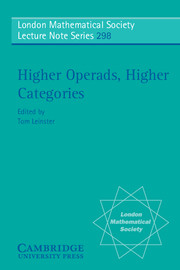Book contents
- Frontmatter
- Contents
- Diagram of interdependence
- Acknowledgements
- Introduction
- Motivation for topologists
- Part I Background
- 1 Classical categorical structures
- 2 Classical operads and multicategories
- 3 Notions of monoidal category
- Part II Operads
- Part III n-categories
- Appendices
- References
- Index of notation
- Index
1 - Classical categorical structures
Published online by Cambridge University Press: 08 January 2010
- Frontmatter
- Contents
- Diagram of interdependence
- Acknowledgements
- Introduction
- Motivation for topologists
- Part I Background
- 1 Classical categorical structures
- 2 Classical operads and multicategories
- 3 Notions of monoidal category
- Part II Operads
- Part III n-categories
- Appendices
- References
- Index of notation
- Index
Summary
We will need to use some very simple notions of category theory, an esoteric subject noted for its difficulty and irrelevance.
Moore and Seiberg (1989)You might imagine that you would need to be on top of the whole of ordinary category theory before beginning to attempt the higher-dimensional version. Happily, this is not the case. The main prerequisite for this book is basic categorical language, such as may be found in most introductory texts on the subject. Except in the appendices, we will need few actual theorems.
The purpose of this chapter is to recall some familiar categorical ideas and to explain some less familiar ones. Where the boundary lies depends, of course, on the reader, but very little here is genuinely new. Section 1.1 is on ordinary, ‘1-dimensional’, category theory, and is a digest of the concepts that will be used later on. Impatient readers will want to skip immediately to Section 1.2, monoidal categories.
This covers the basic concepts and two kinds of coherence theorem. Section 1.3 is a brief introduction to categories enriched in monoidal categories. We need enrichment in the next section, 1.4, on strict n categories and strict ω categories. This sets the scene for later chapters, where we consider the much more profound and interesting weak n -categories. Finally, in Section 1.5, we discuss bicategories, the best-known notion of weak 2-category, including coherence and their (not completely straightforward) relation to monoidal categories. Examples of all these structures are given. Topological spaces and chain complexes are, as foreshadowed in the Motivation for topologists, a recurring theme.
This section is a sketch of the category theory on which the rest of the text is built.
- Type
- Chapter
- Information
- Higher Operads, Higher Categories , pp. 23 - 56Publisher: Cambridge University PressPrint publication year: 2004



